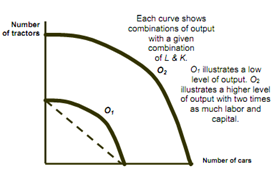Production:
- Firms should choose how much of each to produce.
- The alternative quantities can be illustrated by using product transformation curves.
Product Transformation Curve

* Observations
- Product transformation curves are sloped negatively
- Constant returns are there in this example
- As the production transformation curve is concave is joint production desirable?
- There is no direct relationship between economies of scope and economies of scale.
- May experience diseconomies of scale and economies of scope.
- May have the economies of scale and don't have economies of scope.
* The degree of economies of scope measures savings in cost and can be given as:

- C(Q1) is cost of producing Q1
- C(Q2) is cost of producing Q2
- C(Q1Q2) is joint cost of producing both products
* Interpretation:
- If SC > 0 -- Economies of scope
- If SC < 0 -- Diseconomies of scope
* Issues
- Truckload versus less than truck load
- Direct versus indirect routing
- Length of haul